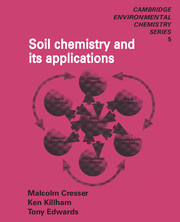2 - Inorganic and mineral components of soils
Published online by Cambridge University Press: 05 August 2012
Summary
As we saw in Chapter 1, rock plays a vital role in soil formation, whether the soil evolves from solid, outcropping rock weathering in situ or from fragments which have broken away from massive outcrops and been transported, often down slope. This movement occurs as a consequence of the action of forces arising from gravity, wind, rain, ice movement or drainage water, either alone or in combination. It may result in a substantial degree of mixing of parent materials. Clearly the origins, and hence the chemical composition, of the parent rock might be expected to influence significantly the chemical and physical properties of the evolving soil at any stage in its development, and this is indeed the case. In the present context we need to consider the properties of rocks insofar as they influence the characteristics of the soils ultimately obtained, and the transformations which rock and rock-derived products undergo over the timescale from seconds to tens of centuries resulting from interactions with water and the soil flora and fauna.
The nature of rocks
It is intuitively obvious that rocks are chemically very stable. If they were not, clearly chemical attack upon rock outcrops would be much more rapid than it is. It follows that the chemical bonding in the macromolecules (minerals) that constitute rocks must produce lattices which are very favourable in energetic terms. Disruption of the lattice, i.e. dissolution, requires a high input of energy to overcome the forces holding the atoms together into well-defined mineral lattices.
- Type
- Chapter
- Information
- Soil Chemistry and its Applications , pp. 10 - 27Publisher: Cambridge University PressPrint publication year: 1993

